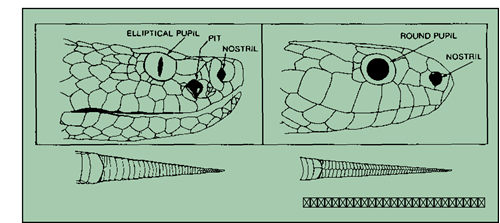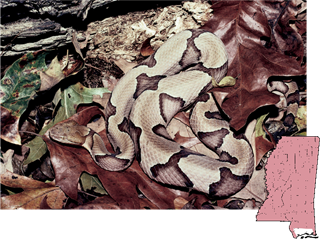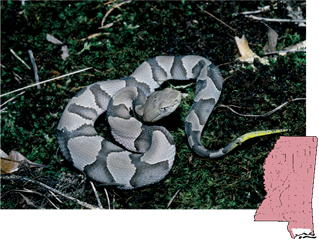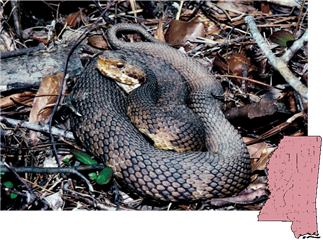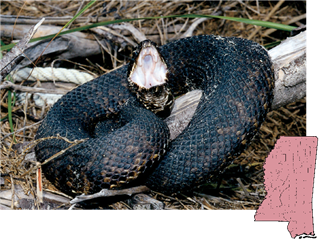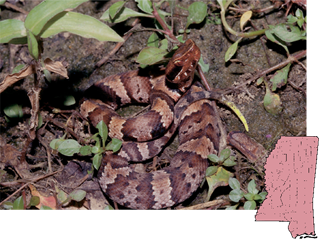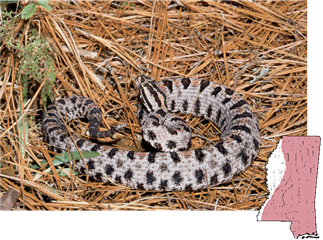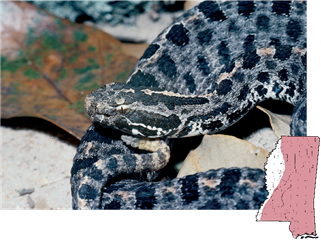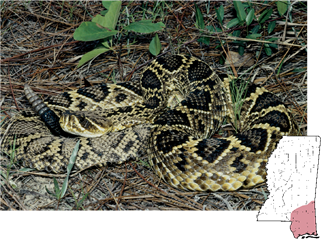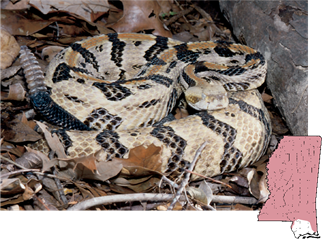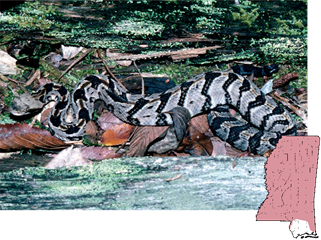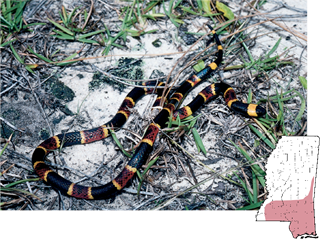Story written by Terry Vandeventer for the Mississippi Department of Wildlife, Fisheries, and Parks
Snakes are peaceful, retiring creatures. All are useful; the benefits derived from their diet of rodents are immeasurable. They are graceful, elegant, and often brightly colored. If you fear them, try to learn more about them.
Learning to recognize the difference between venomous and nonvenomous snakes is not a particularly difficult task. Most of our venomous species have characteristics which are not shared by harmless snakes. Of the 55 different kinds of snakes in Mississippi, only six are venomous. Harmless snakes are more common, but encounters with venomous snakes do occur, and one should always be alert while enjoying outdoor activities.
Most people are uncomfortable around snakes and may be uncertain of their ability to identify them. Whenever possible, LEAVE SNAKES ALONE. This may sound like sensible advice, however, approximately 75 percent of all bites by venomous snakes occur when an individual is trying to kill or otherwise harass the snake. Snakes are not aggressive. Snakes do not chase people and they bite only when they are threatened. When approached most flee, or lie motionless in an effort to blend into their surroundings and escape notice.
The best way to recognize venomous snakes is to learn their identifying characteristics, particularly their color patterns. However, some harmless snakes have the general appearance of being venomous and even behave like venomous snakes (hissing, flattening the head, vibrating the tail, etc.). Most venomous snakes have wide, triangular-shaped heads but unfortunately many nonvenomous snakes have wide heads as well. On the other hand, the deadly coralsnake has a narrow head. Head shape can prove useful in some cases but is never 100 percent reliable in determining venomous vs. nonvenomous. Refer to the characteristics illustrated on this poster for reliable identification. If you have any doubts, leave the snake alone and walk away.
The illustrations, photographs, and range maps of Mississippi’s six venomous snakes are shown on this poster as an aid to their identification. Where appropriate, geographic variations in coloration, or those associated with age are illustrated by photos. Remember that general coloration can vary considerably from snake to snake even from the same region. Rare, occasional abnormalities (i.e., albinism, color or pattern aberrancies, etc.) may occur in nature. Such novelties may be interesting to the biologist but could prove confusing to the average person. Again, use caution and just walk away if in doubt.
Venomous Snake Identification
As a resident of Mississippi, it is important that you learn to identify the species of snakes that are dangerous to human beings. Then by process of elimination, all others can be recognized as nonvenomous. Knowing the following characteristics of venomous snakes may be helpful.
If the snake is dead or safely contained behind glass, look for the following features. If it has any of these it’s venomous:
Facial Pits:
Located between and slightly below the eye and nostril on each side of the head. These indentations are heat-sensitive scanners which detect changes in temperature, serving as an aid to the snake in hunting its food and identifying large warm-blooded predators. Snakes with these organs are collectively called pitvipers.
Vertically Elliptical Pupils:
Rattlesnakes, cottonmouths, and copperheads have slit-like pupils (cat-eyes). Native nonvenomous snakes have pupils which are round.
Single Scale Rows Underneath Tail:
If the scales crossing the underside of the tail are made up of single rows (just like the regular belly scales), the snake is venomous. Native Mississippi nonvenomous snakes have a double row under the tail.
Rattle on Tail:
Three of our six venomous snakes are rattlesnakes. The rattle consists of dry, interlocking segments which click together to create a sizzling sound. Babies have a single button and new segments are added with each shedding of the skin. Pigmy rattlers have only a small rattle which produces a sound no louder than a buzzing insect.
RED-Yellow-Black Rings:
No pits, rattles, or “cat-eyes”- the coralsnake breaks the rules. Brightly banded with red, yellow, and black, the warning colors are side-byside (“red touches yellow, kill a fellow”). In the similarly colored and totally harmless “false coralsnakes” the red and yellow rings are separated by black (“red touches black, friend of Jack”).
Copperhead (Agkistrodon contortrix)
Copperhead Agkistrodon contortrix (northern Miss.)
Copperhead Agkistrodon contortrix (color variation)
Copperhead (juvenile coloration)
Average length is 2 to 3 feet. Ground color is light gray or beige with darker brown hourglass-shaped crossbands, often with a pinkish or orange wash. The distinctive crossbands are often incomplete or broken at mid-body. A thin dark line runs back from the eye to the corner of the mouth. Newborn copperheads have bright sulfur-yellow tails. Contrary to the popular name, copperheads in the South only rarely have copper-red heads.
Easily one of our most common snakes, copperheads are found everywhere except on the immediate Gulf Coast and the barrier islands. Favored habitat is hardwood forest but pine country, old fields, and bottomlands are frequented. Copperheads even inhabit outlying subdivisions, often being discovered in gardens or carports. Most commonly they are observed crossing rural roads at night, or as they are uncovered in woodpiles or trash heaps. Their near-perfect camouflage renders them virtually invisible under most natural situations.
Copperheads feed on rodents, small birds, lizards, frogs, and insects (especially cicadas). Babies of both the copperhead and its close relative the cottonmouth wriggle the bright yellow tail as an enticing lure for frogs and lizards. With age the yellow disappears and is replaced with black.
Copperheads go by several other common names in Mississippi including “highland moccasin” and “rattlesnake pilot.” Often greatly feared by residents, copperheads generally tend to freeze in place (hoping to go unnoticed), or flee at the approach of a human. Bites occur when the snake is accidentally touched or stepped upon, or when the person is trying to kill it.
Cottonmouth (Agkistrodon piscivorus)
Cottonmouth Agkistrodon piscivorus
Cottonmouth Agkistrodon piscivorus (Delta & Gulf Coast coloration)
Cottonmouth (juvenile coloration)
Average length is 2 1/2 to 4 feet. This is a very heavy bodied snake. Adults are brown to khaki-green to black with indistinct wavy, darker crossbands. Populations from the Delta and immediate Gulf Coast are often extremely dark. Over much of the state adults are more brownish or yellowish-brown. Baby cottonmouths are beautifully marked with reddish crossbands on a pink or rusty ground color. These juveniles resemble their close relative the copperhead. However, baby cottonmouths have a wide dark band on the side of the face while all ages of copperheads display a narrow line. Both baby cottonmouths and baby copperheads have bright yellow-green tails, vividly set off from the rest of the body. Cottonmouths of all ages gape the mouth wide-open when threatened.
This medium to large pit viper goes by several common names in Mississippi, including “water moccasin” and “stump-tailed moccasin.” It can be easily confused with several other species of large, dark-colored, thick-bodied, wide-headed but utterly harmless watersnakes (genus Nerodia). All snakes found near the water should be treated with caution.
The cottonmouth frequents creeks, swamps, bayous and virtually all aquatic habitats in the state, including brackish coastal marshes and the barrier islands. Occasional specimens turn up seemingly far from water. They are often abundant in suitable habitats throughout Mississippi. The diet is quite varied, including fish, frogs, snakes and other reptiles, small birds, and mammals.
Cottonmouths are nervous and irritable when cornered. Upon confronting a potential enemy, the snake often opens its mouth, exposing the light interior. This “cotton-white” color contrasts well against the dark snake and draws attention to it, allowing one the opportunity to see the snake and retreat before an actual encounter. The cottonmouth is our primary snakebite species in Mississippi and extremely serious medical implications have been documented following bites of this snake.
Pigmy Rattlesnake (Sistrurus miliarus)
Pigmy Rattlesnake Sistrurus miliarius
Pigmy Rattlesnake Sistrurus miliarius (Gulf Coast)
Average length is 18 to 20 inches. Dark spots run down the back of the snake, with one or two alternating rows down each side. Overall, the snake may be quite dark, especially in specimens from the southern counties. Pigmy rattlers have nine large symmetrically arranged scales on the crown of the head. (Our other larger rattlers have tiny, randomly arranged scales on top of the head). Rattles on the tail are tiny in size. Often the rattle is temporarily missing but grows back with subsequent moltings.
The most commonly heard name for this snake in Mississippi is “ground rattler.” Unfortunately, this is also the name given to the several small gray or brown harmless snakes found in yards and gardens throughout the South (genera Virginia, Storeria, and Rhadinaea). While popular consensus is that the pigmy rattlesnakes do not possess rattles and are therefore silent, the opposite is actually true. They do indeed have functional rattles. The appendage is small and easily broken off and regained repeatedly throughout the life of the snake.
Pigmy rattlesnakes range over most of Mississippi although records are lacking from the Delta. Distribution is spotty with the species being most common on the Gulf Coast and again in northeastern Mississippi. They prefer flatwoods, both pine and hardwood forests, and the environs of swamps. Food consists of small snakes, lizards, frogs, and mice.
Bites on humans are fairly common in the southern counties. Although this species produces a highly toxic venom, the small size of the snake reduces the risk of a fatal bite. While no person has yet died of a pigmy rattlesnake bite, many serious bites and “close-calls” have been recorded.
Eastern Diamondback Rattlesnake (Crotalus adamanteus)
Eastern Diamondback Rattlesnake Crotalus adamanteus
This is our largest rattlesnake. Average length is 4 to 5 1/2 feet; recorded to nearly 8 feet. This snake is massive in build and the head is very broad. The color is medium brown or tan with dark diamond-shaped markings. Each diamond is bordered by a single row of light colored scales. General coloration fades to a lighter hue toward the tail. Each side of the head has a wide dark stripe bordered on both sides with lighter scales. There is a prominent rattle on tail.
An encounter with an adult eastern diamondback rattlesnake can be an awesome event. The sheer size and bulk of a large specimen is impressive indeed, and no other Mississippi snake reaches such proportions. When at rest on the surface, eastern diamondbacks usually coil next to a log, uprooted tree stump, or in the close proximity of a gopher tortoise burrow. Here the snake blends well with grasses and low shrubs, and can be extremely difficult to see. From here they usually choose to lie still and quiet rather than draw attention to themselves. Under other circumstances or if outwardly challenged, an eastern diamondback may rattle and blow loudly, and subsequently bite if approached to within striking range.
Eastern diamondbacks were once common in the longleaf pine forests of southern Mississippi. Habitat destruction, human persecution, and road mortalities have eliminated diamondbacks from most of the historic range in Mississippi.
Adult eastern diamondback rattlesnakes feed almost exclusively on large rodents and rabbits. Rarely, ground-dwelling birds such as quail are taken. Babies are born in September and at 14 inches long can kill and swallow adult mice.
Many experts believe that this large rattlesnake is in serious need of protection. An encounter can certainly be a memorable experience so for your own safety and concern for a diminishing species, back off and give the eastern diamondback a wide berth.
Canebrake Rattlesnake (Crotalus horridus)
Canebrake Rattlesnake Crotalus horridus
Canebrake Rattlesnake (juvenile showing single button)
Average length is 3 to 4 1/2 feet. Ground color is gray to tan, often with a distinct pinkish wash. Wavy black bands cross the body. Overall coloration grows darker toward the tail. The tail is velvet-black. A single dark stripe runs back from each eye. A narrow rusty-red line follows the spine down the length of the snake. There is a prominent rattle on tail.
In Mississippi these snakes are almost exclusively referred to as “timber rattlers.” To a lesser extent the names “velvet-tailed rattler” and “diamondback” are used for this animal. Interestingly, the animal does not have diamond-shaped markings nor any real resemblance to the much larger eastern diamondback rattlesnake. In comparison, the canebrake rattlesnake is more slender with a proportionately smaller head than the eastern diamondback.
Canebrake rattlesnakes inhabit forest and river bottoms throughout the state, save the immediate Gulf Coast. Unfortunately, they have been exterminated over much of their historic range and their numbers continue to decline at an alarming rate. The female canebrake rattlesnake produces about a dozen live young only once every third year, resulting in a very low reproductive rate. Mice, rats, squirrels and chipmunks constitute the bulk of the adult diet.
As rattlesnakes go, the canebrake rattlesnake is calm and often slow to defend itself. Wild individuals rarely rattle at a human’s approach. Rather, they remain motionless and silent, or opt for a hasty retreat. In Mississippi the majority of bites of humans by canebrake rattlesnakes result from the person’s attacking the snake or otherwise trying to handle it.
Coralsnake (Micrurus fulvius)
Coralsnake Micrurus fulvius
Average length is 2 to 3 feet. The body is slender and cylindrical with a small head and tiny black eyes. This snake is brightly ringed with wide black and wide red bands, separated by narrow yellow bands. The red rings almost always have elements of black, especially in older snakes. The yellow and red bands are always side-byside. Think of the red and yellow colors of a traffic light always being together. The scarlet kingsnake is a “mimic” which is harmless but derives some protection from attackers by resembling the deadly coralsnake. In the harmless mimic however, the two warning colors are never in contact.
Coralsnakes inhabit sandy pinewoods in the southeastern counties of Mississippi. They are secretive and generally uncommon, even rare. Specimens are usually active in the daytime and often turn up in yards and gardens of houses situated near suitable habitat. While deadly in nature, coralsnakes inhabiting Mississippi are quite inoffensive.
They bite when touched, pinned down or purposely handled by uninformed people. Contrary to popular beliefs, the coralsnake does indeed possess venom-conducting fangs. They do not have to chew on the victim in order to introduce the venom into the wound. A coralsnake can open its mouth 180 degrees so it is not at all limited
to biting areas such as the earlobe or between the toes. And most importantly, while coralsnake bites always represent a life and death situation, bites are not anywhere near 100% fatal to people.
Coralsnakes feed on small snakes and to a lesser extent on lizards. One of several facts that separate coralsnakes from the five pitvipers inhabiting our state is that of reproduction. Coralsnakes lay eggs while our native pitvipers are livebearers.
Emergency Treatment
Do
- Calm and reassure the victim; don’t panic.
- Remove all rings, bracelets or other constricting items.
- Immobilize the bitten area as much as circumstances allow.
- Keep the bitten area at or slightly below heart level.
- Wash area thoroughly.
- Take victim to medical facility as quickly as possible.
- Be prepared to treat for shock.
- Be prepared to initiate cardiopulmonary resuscitation (CPR) if required.
Don’t
- Do not give victim any drink or food by mouth.
- Do not place ice on bitten extremity.
- Do not make any cuts in or around the bite area.
- Do not administer any drugs to the patient (particularly antivenin.)
- Do not apply a tourniquet to the affected extremity.
- Do not attempt to remove venom by mouth suction over the wound.
- Do not treat snakebites with electrical shock.
To Reduce the Risk of Being Bitten
- When you are in areas where there may be snakes, wear long pants and/or shoes that protect your ankles.
- Always look carefully where you are walking or placing your hands.
- Always use a flashlight for activities after dark such as gathering firewood.
- Choose a campsite that is away from woodpiles, cave entrances, swampy areas, or thick underbrush.
- Use care when moving boats left on shore for several hours.
- If you see a snake carefully step away from it. Never attempt to capture or kill snakes.
- Treat “dead” snakes as you would live snakes.
- If you are attempting to identify a snake, make sure you are not within its striking distance, which is usually 2/3 of the snake’s body length.
- Bring a companion when traveling in areas where there may be snakes.
- Remember that venomous snakes can climb trees, can bite under water, and may enter saltwater.
Suggestions for Avoiding Snakebites
Don’t Kill Snakes:
Snakes are important predators on injurious rodents and insects. The vast majority are nonvenomous and completely harmless to people. Nearly all snakebites take place while people are killing the snake or otherwise tormenting, capturing, skinning, or handling them.
Watch Where You Walk, Sit or Place Your Hands:
Snakes like to hide in stumpholes, under boards and sheet metal, in brush piles, and next to fallen logs. If you encounter one, simply back away from the snake.
Leave DEAD Snakes Alone:
Recently killed snakes can bite reflexively. Never try to examine the mouth for the presence of fangs to determine if the snake is venomous. The fangs are enclosed within gum tissue and may be difficult to locate.
Keep Your Property Clean:
One can never completely rid a given area of snakes. To reduce the number of snakes around your property, keep areas free of trash, brush
and log piles. Mow the grass near your home frequently. Rats and mice make up the diet of most snakes and they are attracted to unkempt areas. As a result, snakes follow in search of both food and shelter.
Snake Repellents Do Not Work:
Substances such as pesticides, kerosene, diesel oil, sulfur and mothballs, as well as commercially available “repellents” are ineffective and extremely dangerous to spread around your home.
Remember:
- More than 85% of all snakebites are by nonvenomous species.
- Of all bites by venomous snakes, 25-50% do not inject any venom.
- More importantly, mortality is less than 1% for physician-treated venomous snakebites in the United States.
The post Everything you need to know about venomous snakes of Mississippi appeared first on SuperTalk Mississippi.



